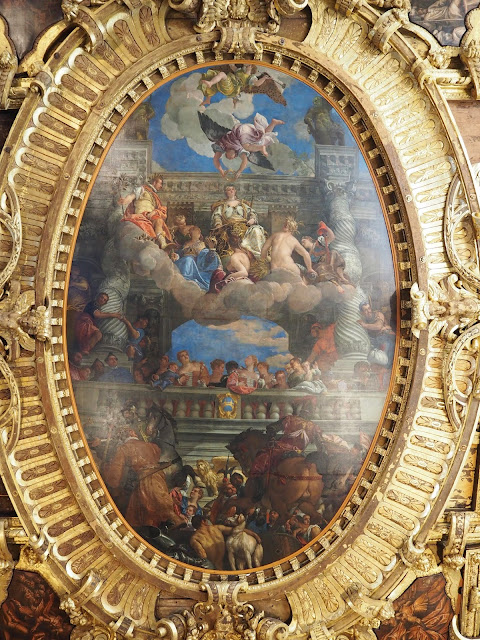【ヴェネツィア】ヴェネツィア共和国の中枢 ドゥカーレ宮殿② Venezia - The center of the Republic of Venice, Palazzo Ducale Part-2
ドゥカーレ宮殿の内部は、主に3階と4階が見学コースになっている。
1階から、階段を4階までゆっくりと上がっていく。この同じ階段を、ヴェネツィア共和国の歴代の総督たちも上がっていったのだろうかと考えると、歴史のロマンを感じる。
各階には、沢山の部屋があり、その一つ一つを進んでいく。
Inside the Doge's Palace, the tour courses are mainly on the 3rd and 4th floors.
From the 1st floor, slowly go up the stairs to the 4th floor. I feel the romance of history when I wonder if the successive governors of the Republic of Venice also went up this same staircase.
There are many rooms on each floor, and you can go through each one.
ヴェネツィア共和国の政策の全てが決められたこの宮殿。その壁の絵を描くのは、ヴェネツィアを代表する画家たちだった。
各国の大使との謁見や、条約の調印などに使われたという謁見の間。その奥には、パオロ・ヴェロネーゼの『レパントの海戦の勝利を感謝するヴェニエル総督』が描かれている。
レパントの海戦は、1571年にオスマン帝国とスペイン・ヴェネツィア・ローマ教皇の連合軍の間で行われた海戦で、地中海全域における派遣を目指していたオスマン帝国側の敗北に終わった。
この戦いのことは、塩野七生の『レパントの戦い』から多くを知った。
ヴェネツィア共和国はこの戦いを実質的に主導し、この勝利はほとんどヴェネツィアの勝利といっても良かったが、皮肉にも、この海戦はヴェネツィア凋落の大きなきっかけになった。
この海戦は、ヴェネツィア海軍が誇るガレー船が主体となった最後の開戦と言われ、この後は、スペインやオスマン帝国などの広大な領土を誇る国々が、巨大な戦艦で戦うのが海戦の主流になった。
This palace has all the policies of the Republic of Venice. It was the painters representing Venice who painted the walls.
During an audience with the ambassadors of each country and the fact that it was used to sign treaties. Behind it is Paolo Veronese's "Governor Veniel Thanking for the victory of the Battle of Lepanto".
The Battle of Lepanto was a naval battle between the Ottoman Empire and the Allied Forces of the Popes of Venice, Spain and Rome in 1571, and ended in the defeat of the Ottoman Empire, which was aiming to be dispatched throughout the Mediterranean Sea.
I learned a lot about this battle from Nanami Shiono's "Battle of Lepanto".
The Republic of Venice effectively led the battle, which was almost a victory for Venice, but ironically, the naval battle was a major catalyst for the decline of Venice.
This naval battle is said to be the last battle in which the Venetian Navy's galleys were the main players, and after that, countries boasting vast territories such as Spain and the Ottoman Empire will fight with huge battleships.
この海戦でヴェネツィア側の指揮官だったのは当時75歳だったセバスティアーノ・ヴェニエルだった。この海戦の後、ヴェニエルは81歳という高齢で総督に選ばれている。
このセバスティアーノ・ヴェニエルの姪子が、地中海を航行中にイスラム教徒の海賊に襲われて、海賊は彼女をオスマントルコのスルタンに売り渡した。
彼女は、ヌール・バーヌー、光の姫と改名して、ハーレムにおいてセリム2世に愛され、その後継のセリム3世を生んだ。
ヌール・バーヌーはスルタンの母親となり、摂政として政治の実権を握り、フランスのカテリーヌ・ド・メディシスやイギリスのエリザベス女王と協力関係を結んで、オスマン帝国の外交を親ヴェネツィアの方向に誘導した。
そのため、ヴェネツィアと敵対するジェノヴァからは目の敵とされ、1587年にはそのジェノヴァの放った刺客によって、毒殺されたと言われている。
オルハン・パムクの小説『わが名は紅』は、そのセリム3世の時代が舞台になっている。
The Venetian commander of the naval battle was Sebastiano Veniel, then 75 years old. After this naval battle, Veniel was elected governor at the age of 81.
The Sebastiano Veniel's niece was attacked by a Muslim pirate while sailing in the Mediterranean, who sold her to the Ottoman Sultan.
She was renamed Noor Banu, Princess of Light, and was loved by Selim II in Harlem, giving birth to her successor, Selim III.
Noor Banu became Sultan's mother, took control of politics as a regent, and collaborated with Caterine de Medicis of France and Queen Elizabeth of England to guide the diplomacy of the Ottoman Empire toward pro-Venice.
Therefore, it is said to be an enemy of the eyes of Genoa, who is hostile to Venice, and was poisoned in 1587 by the thugs released by Genoa.
Orhan Pamuk's novel "My Name is Red" is set in the era of Selim III.
それまでは、内障は豪華だが、比較的小さな部屋を順々に回ってきたので、いきなり大きな部屋が現れて、その大きさに驚かされる。
ドゥカーレ宮殿は、最初に建てられてから何度か火災に襲われてきた。
1574年の火災は中でも大規模なもので、この大評議の間も含めた多くの部分が焼け落ちてしまった。
それまではグアリエントの『天国』が描かれていたが、建物の修復後に、同じテーマの作品をティントレットが描き、それが今もそこにある。
On the 3rd floor, there is a large council room, which can be said to be the highlight of this visit to the Doge's Palace.
Until then, the internal disorders were gorgeous, but as I went around the relatively small rooms one after another, a large room suddenly appeared and I was surprised at its size.
The Doge's Palace has been hit by fire several times since it was first built.
The 1574 fire was one of the largest, with many parts burned down, including during this great council.
Until then, Guarient's "Heaven" was drawn, but after the restoration of the building, Tintoretto drew a work of the same theme, which is still there.
とにかく巨大な作品で、その雰囲気に圧倒される。
画面中央の上部に描かれている、キリストと聖母マリア。その光の方向に画面上の人々の視線が向けられていて、この絵を見る人々の視点も、自ずとそちらに導かれていく。
Anyway, it's a huge work, and I'm overwhelmed by the atmosphere.
Christ and the Virgin Mary depicted at the top center of the screen. People's eyes on the screen are directed in the direction of the light, and the viewpoints of the people who see this picture are naturally guided there.
天井を見上げると、そこにはヴェロネーゼの描いた『ヴェネツィアの勝利』がある。
広い室内の壁の上部には、歴代の総督76人の肖像画が描かれている。
ティントレットの『天国』の反対側の左端には、総督でありながらクーデターを企てて処刑されたマリーノ・ファリエロの部分に黒い旗が描かれている。
この大評議の間が再建されてから、ヴェネツィアは徐々に国際政治における力を失っていった。
この場所で、それ以降の歴代の総督や貴族たちは、おそらく苦しい決断を何度も行わなければならなかったのかもしれない。
Looking up at the ceiling, there is Veronese's "Victory of Venice".
At the top of the wall in the large room, portraits of 76 successive governors are drawn.
On the far left of Tintoretto's "Heaven", a black flag is drawn on the part of Marino Faliero, who was executed in an attempt to coup d'etat while being governor.
After the reconstruction during this great council, Venice gradually lost its power in international politics.
At this location, successive governors and aristocrats probably had to make many difficult decisions.
(Translated by Google Translate)








コメント
コメントを投稿